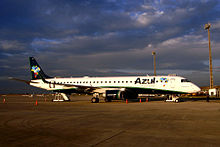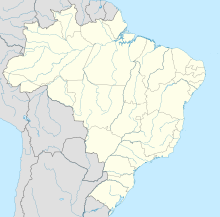
Viracopos International Airport

Viracopos/Campinas International Airport Aeroporto Internacional de Viracopos/Campinas | |||||||||||
|---|---|---|---|---|---|---|---|---|---|---|---|
 | |||||||||||
 | |||||||||||
| Summary | |||||||||||
| Airport type | Public | ||||||||||
| Operator |
| ||||||||||
| Serves | Campinas | ||||||||||
| Location | Campinas, São Paulo, Brazil | ||||||||||
| Hub for | |||||||||||
| Time zone | BRT (UTC−03:00) | ||||||||||
| Elevation AMSL | 661 m / 2,170 ft | ||||||||||
| Coordinates | 23°00′25″S 047°08′04″W / 23.00694°S 47.13444°W | ||||||||||
| Website | www | ||||||||||
| Map | |||||||||||
 | |||||||||||
| Runways | |||||||||||
| |||||||||||
| Statistics (2023) | |||||||||||
| |||||||||||
Viracopos/Campinas International Airport (IATA: VCP, ICAO: SBKP) (sometimes referred to as São Paulo/Campinas or São Paulo/Viracopos) is an international airport serving the municipality of Campinas, in the state of São Paulo.

On 6 January 1987, the airport name was officially normalised to its present form.[5] It is named after the neighbourhood where it is located.

It is operated by Aeroportos Brasil.

History

The IATA airport code of Viracopos is VCP and the specific city code of Campinas is CPQ. Sometimes both codes are used as one although there is a distinction between them in airline reservation systems: VCP, together with CGH (Congonhas) and GRU (Guarulhos), is part of the multiple airport system set around the city of São Paulo (code SAO). An airline that files services with the code VCP has flights displayed when passengers or travel agents request service from São Paulo, whereas flights filed with the code CPQ are displayed as service from Campinas, not São Paulo. A similar example is New York City (NYC), in which the airport codes LGA (LaGuardia Airport), JFK (John F. Kennedy International Airport), and EWR (Newark Liberty International Airport) are used for the same city, although Newark is located in a different city and state.

There are two versions of the origin of the name Viracopos, which means "turn (or overturn) glasses" in Portuguese and can be metaphorically understood as drinking a large amount of an alcoholic beverage at once. According to the first version, in the beginning of the 20th century, during an annual fair, there was a misunderstanding between the parish priest and the residents of the neighborhood. This resulted in excessive drinking and quarrels, in which the festival booths were torn down, or overturned, during the confusion. The name "Viracopos" was later used by the priest in sermons to refer to the event. Another version says that, on the site of the present airport, previously there had been a bar where herders had regularly met to exchange views and drink ("turn glasses"). So "Viracopos" was first the name of the district and later of the airport.

The origin of Viracopos Airport can be traced to a simple airfield near Campinas built during the 1932 Constitutionalist Revolution in São Paulo. In 1946, shortly after World War II, the first runway was paved. In the following years, the airport began to take shape, with the construction of the first hangar in 1948 and the terminal in 1950.[6][7] During the 1950s, it started being used by cargo companies. In 1960, it was improved with a 3,240 m runway, long enough to accommodate the first generation of intercontinental jet planes such as the Boeing 707, de Havilland Comet, Vickers VC10, Convair 990, and Douglas DC-8, and the airport was officially inaugurated on 19 October 1960, same day where it also received its first international flight.[8] Furthermore, Viracopos Airport served (and still serves) as an alternate airport for Rio de Janeiro-Galeão International Airport and São Paulo airports particularly because it rarely closes due to bad weather conditions (an average of only 5 days per year).[9]

After 1960, Viracopos became the primary international airport for São Paulo, because the runway of São Paulo-Congonhas Airport was too short to accommodate intercontinental jet planes. In practice, however, the distance of nearly 100 km from Viracopos to São Paulo made it very inconvenient for passengers and airlines. As a result, direct international passenger service was limited, because most international passengers simply opted to fly instead to Rio de Janeiro-Galeão International Airport and then connect to Congonhas Airport, which is located very close to downtown. At that time, Viracopos even appeared on the Guinness Book of Records as the furthest airport from the city it allegedly served.

The airport's title as the main international airport of São Paulo ended in 1985 with the opening of São Paulo-Guarulhos International Airport, and Viracopos entered into a decade of stagnation, with all international and most domestic flights transferred to Guarulhos and Congonhas.[8]

However, recognizing the strategic importance of Viracopos for the economy, Infraero, the airport administrator in 1995, started to implement a master plan of renovations aiming at the building of a new airport, focusing its efforts on the segment of cargo transportation. The first phase was completed in the first half of 2004, when the airport received new passenger departure and arrival lounges, public areas, commercial concessions and a new cargo terminal. The second phase of the passenger terminal expansion project was completed in 2005 and a new control tower was built, storage and processing facilities for the cargo terminal expanded, and the passenger terminal was entirely revamped. A third phase of expansion, which would build a second runway by 2013, was projected. However, since the airport was conceded in 2012, the deadline for the new runway was postponed until 2018.

Being the second busiest cargo airport in Brazil, Viracopos has 77,000 square meters (646,000 square feet) of cargo terminals, 1,700 square meters (18,300 square feet) for animal cargo, and 1,480 cubic meters (52,200 square feet) of refrigerated space. As a major import/export hub, Viracopos enjoys 'express lanes' for courier traffic which are exceptionally quick and unbureaucratic by Brazilian standards.

Between 2008 and 2010, passenger traffic grew from 1.02 million in 2008 to 7.5 million in 2011. The airport can handle 7 million passengers/year.[9] The number of flights offered has increased dramatically since Azul Brazilian Airlines made Viracopos its main hub.

In August 2009, the previous operator Infraero unveiled a R$2,814 million (US$1,482.6 million; €1,038.8 million) investment plan to upgrade Viracopos International Airport, focusing on the preparations for the 2014 FIFA World Cup and the 2016 Summer Olympics. The investment intended to provide a new runway, a new passenger terminal, and a new train route, with its main goal being to alleviate the air-traffic concentrated at Guarulhos International Airport.[10]

However, due to legal and bureaucratic issues, the Infraero original plan never occurred. Since the concession to Consortium Aeroportos Brasil, a new investment program focusing particularly on the construction of a new terminal was announced. The phase 1 of the new passenger terminal opened in May 2015.[11]

Responding to critiques to the situation of its airports, on May 18, 2011, Infraero released a list evaluating some of its most important airports according to its saturation levels. According to the list, Viracopos was considered to be requiring attention, operating between 70% and 85% of its capacity.[12]

Following a decision made on 26 April 2011 by the Federal Government for private companies being granted concessions to operate some Infraero airports,[13] on 6 February 2012, the administration of the airport was conceded, for 30 years, to the Consortium Aeroportos Brasil composed of the Brazilian Triunfo,[14] an Investments and Funds Society (45%), UTC Engenharia e Participações,[15] an Engineering and Investments Society (45%), and the French Aeroports Egis Avia[16] (10%).[17] Infraero, the state-run organization, remains with 49% of the shares of the company incorporated for the administration.[18][19][20]

The facility encompasses 1,766 hectares (4,364 acres) of airport property and contains one 3,240m runway.[21]

Airlines and destinations
Passenger
Cargo
Statistics



Following is the number of passenger, aircraft and cargo movements at the airport, according to Infraero (2007-2012) and Aeroportos Brasil (2013-2023) reports:[27][28][1]

| Year | Passenger | Aircraft | Cargo (t) |
|---|---|---|---|
| 2023 | 12,524,219 |
125,857 |
294,094 |
| 2022 | 11,845,500 |
128,341 |
349,888 |
| 2021 | 10,045,361 |
105,320 |
357,368 |
| 2020 | 6,709,061 |
73,698 |
256,470 |
| 2019 | 10,585,018 |
114,459 |
216,447 |
| 2018 | 9,223,074 |
107,627 |
235,324 |
| 2017 | 9,332,631 |
108,635 |
198,876 |
| 2016 | 9,325,252 |
115,276 |
164,429 |
| 2015 | 10,324,658 |
127,395 |
177,285 |
| 2014 | 9,846,853 |
131,531 |
217,519 |
| 2013 | 9,295,349 |
127,252 |
235,182 |
| 2012 | 8,858,380 |
115,548 |
246,226 |
| 2011 | 7,568,384 |
99,982 |
267,946 |
| 2010 | 5,430,066 |
74,472 |
255,008 |
| 2009 | 3,364,404 |
55,261 |
184,745 |
| 2008 | 1,083,878 |
32,399 |
223,023 |
| 2007 | 1,006,059 | 29,226 | 229,402 |
Accidents and incidents
- 23 November 1961: an Aerolíneas Argentinas de Havilland DH-106 Comet 4 registration LV-AHR operating flight 322 from Campinas-Viracopos to Port of Spain after reaching an altitude of about 100m lost altitude, collided with a eucalyptus forest and crashed. All 12 crew and 40 passengers on board were killed. The accident was attributed to pilot error.[29]
- 26 September 1976: a Serv-Jet Learjet 25 struck trees during an instrument approach to runway 14 in heavy rain, and crashed 1500m short of the runway. All seven occupants died.[30]
- 4 January 1977: a Transbrasil BAC One-Eleven 520FN landed heavy at VCP because of an improper flare, causing the aircraft to bounce and touchdown nose gear first, collapsing the nose gear and causing a runway excursion. There were no fatalities among the 42 passengers and crew on board, but the aircraft was written off.[31]
- 13 May 1980: a VOTEC Britten-Norman BN-2 Islander disappeared on a survey mission for Project Radam en route near to VCP. The aircraft was never found. Seven occupants perished.[32]
- 13 October 2012: a Centurion Air Cargo McDonnell Douglas MD-11 registration N988AR operating flight 425 from Miami to Campinas-Viracopos lost a landing gear while landing on runway 15, causing damage to both the aircraft and runway. No injuries and deaths were reported. Following the incident, the airport was closed for 45 hours before the damaged aircraft was removed and the runway reopened. This caused a major traffic disruption with the airlines that operate at the airport.[33] This also marked the first time Viracopos Airport had been closed other than weather, ending the airport's 52 year clean record.
Access
The airport is located 82 km (51 mi) northwest of the state capital city of São Paulo and 20 km (12 mi) southwest of downtown Campinas, adjacent to the Bandeirantes-Anhanguera highway complex, which connects the capital city to the interior of São Paulo state.

See also
References
- ^ a b "Estatísticas e Publicações". Aeroportos Brasil (in Portuguese). Retrieved 18 January 2024.
- ^ "Viracopos". Aeroportos Brasil (in Portuguese). Retrieved 10 May 2022.
- ^ "Aeródromos". ANAC (in Portuguese). 22 August 2019. Retrieved 4 August 2020.
- ^ "Estadual de Campos dos Amarais - Prefeito Francisco Amaral (SDAM)". DECEA (in Portuguese). Retrieved 15 April 2024.
- ^ "Lei nº 7.585, de 6 de janeiro de 1987". Presidência da República (in Portuguese). 6 January 1987. Retrieved 19 November 2023.
- ^ Basseto, Murilo (19 October 2020). "Aeroporto de Viracopos completa 60 anos de história comercial". AEROIN (in Brazilian Portuguese). Retrieved 19 June 2023.
- ^ "O início do aeroporto internacional de Viracopos". www.arghi.com.br (in Portuguese). 18 May 2020. Retrieved 19 June 2023.
- ^ a b Azul Brazilian Airlines, ed. (2011). "Viracopos, o nosso escolhido". Bem-vindo à bordo (in Portuguese) (8). Campinas: Azul Brazilian Airlines: 23–25.
- ^ a b Torres, Carmen Lígia (2011). "Capital privado dá novo impulso: Plano do governo federal é criar o maior centro aeroportuário do país". Polo de inovação: Centros de pesquisa são a base do desenvolvimento (in Portuguese). São Paulo: Valor Econômico: 36.
- ^ Rittner, Daniel; Braga, Paulo Victor (31 August 2009). "Infraero vai gastar R$5 bi em reforma de aeroportos". Valor Econômico (in Portuguese). pp. A4. Archived from the original on 6 July 2011. Retrieved 8 July 2011.
- ^ "Home" (in Portuguese). Viracopos. Archived from the original on 24 April 2013. Retrieved 13 April 2013.
- ^ "Governo muda critério de avaliação e 'melhora' desempenho de aeroportos" (in Portuguese). O Estado de S. Paulo. 19 May 2011. Retrieved 20 May 2011.
- ^ Bitencourt, Rafael (26 April 2011). "Governo define concessão de obras em 3 aeroportos, diz Palocci" (in Portuguese). Valor Online. Retrieved 16 May 2011.
- ^ "Home" (in Portuguese). Triunfo. Archived from the original on 6 August 2012. Retrieved 30 August 2012.
- ^ "Home" (in Portuguese). UTC Engenharia e Participações. Archived from the original on 18 June 2012. Retrieved 30 August 2012.
- ^ "Home". Egis Avia. Archived from the original on 16 February 2013. Retrieved 30 August 2012.
- ^ Rittner, Daniel (7 February 2012). "Cumbica, Viracopos e Brasília são privatizados" (in Portuguese). Valor Econômico. Archived from the original on 10 February 2012. Retrieved 22 March 2012.
- ^ Salomon, Marta; Monteiro, Tânia (1 June 2011). "Governo pretende privatizar três aeroportos e abrir o capital da Infraero" (in Portuguese). O Estado de S. Paulo: Economia. Retrieved 22 March 2012.
- ^ "Brazil moves swiftly (at last) to award airport concessions". CAPA. 9 February 2012. Archived from the original on 15 March 2014. Retrieved 5 March 2012.
- ^ "Conheça o Consórcio Aeroportos Brasil que irá operar em Viracopos". Exame (in Portuguese). 6 February 2012. Archived from the original on 22 May 2014. Retrieved 13 April 2013.
- ^ "Facts about Campinas/Viracopos Int'l Airport". aeroportoviracopos.net. Retrieved 26 October 2023.
- ^ "Atlas Air Schedule". Atlas Air. Retrieved 19 December 2023.
- ^ a b "Avião que fez o voo inaugural da DHL tem problema e não consegue decolar de Campinas". Aeroin (in Portuguese). 11 July 2022. Retrieved 22 July 2022.
- ^ a b "Viracopos passa a receber voos cargueiros da Ethiopian Airlines". Panrotas (in Portuguese). 3 March 2021. Retrieved 4 March 2021.
- ^ "FedEx inclui voos para mais um destino na América do Sul e um no Oriente Médio". Aeroin (in Portuguese). 24 November 2022. Retrieved 24 November 2022.
- ^ a b c d e "Schedule". Lufthansa Cargo. Retrieved 23 July 2020.
- ^ "Anuário Estatístico Operacional" (PDF). Infraero (in Portuguese). 12 April 2012. Retrieved 29 February 2024.
- ^ "Estatísticas". Infraero (in Portuguese). 20 May 2015. Retrieved 20 January 2024.
- ^ "Accident description LV-AHR". Aviation Safety Network. Archived from the original on 24 October 2012. Retrieved 27 June 2011.
- ^ Accident description for PT-IBR at the Aviation Safety Network. Retrieved on October 25, 2023.
- ^ Accident description for PP-SDS at the Aviation Safety Network. Retrieved on October 26, 2023.
- ^ Accident description for PT-KHK at the Aviation Safety Network. Retrieved on October 25, 2023.
- ^ Hradecky, Simon (15 October 2012). "Accident: Centurion MD11 at Sao Paulo on Oct 13th 2012, left main gear collapsed during roll out". Aviation Herald. Archived from the original on 26 August 2018. Retrieved 16 October 2012.
External links
![]() Media related to Viracopos-Campinas International Airport at Wikimedia Commons
Media related to Viracopos-Campinas International Airport at Wikimedia Commons

- Airport information for SBKP at Great Circle Mapper. Source: DAFIF (effective October 2006).
- Current weather for SBKP at NOAA/NWS
- Accident history for VCP at Aviation Safety Network
See what we do next...
OR
By submitting your email or phone number, you're giving mschf permission to send you email and/or recurring marketing texts. Data rates may apply. Text stop to cancel, help for help.
Success: You're subscribed now !


